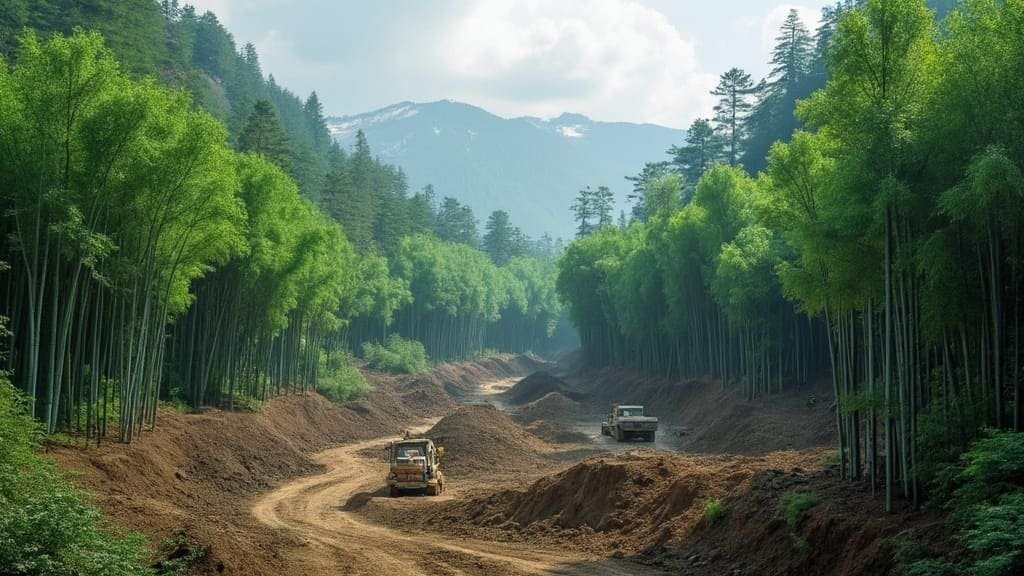Introduction
Deforestation significantly influences the survival of red pandas, a species already classified as endangered
As their habitats in the Himalayan regions face extensive destruction due to logging, agricultural expansion, and urban development, red pandas experience diminishing food supplies, fragmented territories, and declining populations
This article explores the main causes of habitat loss, the consequences of forest fragmentation, and the conservation measures aimed at reversing these trends. We’ll delve into how deforestation alters their ecosystems and what steps are necessary to ensure their survival
Deforestation and Its Direct Impact on Red Panda Habitats
Deforestation is one of the primary threats to the red panda’s survival, as it directly destroys the dense, temperate forests that they call home. Found in the Himalayan regions spanning Nepal, Bhutan, India, Myanmar, and China, red pandas rely heavily on these forests for both sustenance and shelter
However, extensive logging, agricultural conversion, and infrastructure development are rapidly depleting these vital ecosystems, leaving red pandas with fewer resources and fragmented territories
The Primary Causes of Habitat Loss
Red pandas depend on temperate forests rich in bamboo, which forms the majority of their diet. Unfortunately, the demand for timber, paper, and firewood in the Himalayan region has led to unchecked logging in these habitats
According to Shrestha et al. (2019), over 50% of the red panda’s habitat in eastern Nepal has been degraded due to commercial logging and agricultural expansion. This deforestation is compounded by slash-and-burn farming practices, which clear vast tracts of land for subsistence agriculture
Moreover, infrastructural projects such as road construction and hydroelectric dams disrupt forest continuity. Wei et al. (2018) found that these developments not only reduce available habitat but also create noise and pollution that drive red pandas away from otherwise suitable areas
The encroachment of human settlements into forested areas further exacerbates the issue, bringing domestic livestock that compete for food and sometimes introduce diseases to red panda populations
Geographic Hotspots of Deforestation Affecting Red Pandas
The regions most affected by deforestation are those in Nepal and northeastern India, where the Himalayan foothills are experiencing rapid urbanization
Bhutan, despite its smaller size, has also seen forest loss in areas critical for red panda populations, particularly in regions near logging concessions. Shrestha et al. (2019) highlight that in Sikkim, India, forest cover in red panda habitats has decreased by nearly 30% over the past two decades
The red panda’s range in China, primarily the Sichuan and Yunnan provinces, has also been significantly fragmented by agricultural expansion
These regions are known for their dense bamboo forests, but large-scale clearing for tea plantations and other cash crops has left isolated patches of forest unsuitable for long-term population stability
The Role of Bamboo Forest Destruction
Bamboo is essential for the survival of red pandas, constituting about 95% of their diet. As forests are cleared, the availability of bamboo rapidly declines
This not only affects the red panda’s food supply but also its ability to reproduce and rear young. Pimm et al. (2021) reported that the reduction in bamboo coverage has directly led to a 40% decline in red panda populations over the past decade in areas of China and India
Furthermore, bamboo itself is sensitive to climate change, which is often exacerbated by deforestation
The combined stressors of habitat destruction and reduced bamboo availability create a dire situation for the species. Without a stable food source, red pandas may resort to less nutritious diets, leading to malnutrition and decreased reproductive success
The Role of Forest Fragmentation in Red Panda Population Decline
Forest fragmentation, a direct consequence of deforestation, poses a significant threat to red panda populations by breaking up their habitats into smaller, isolated patches
Unlike outright habitat destruction, fragmentation disrupts the ecological balance of these areas, making it difficult for red pandas to sustain their populations
The impacts of fragmentation range from limited movement and access to resources to decreased genetic diversity and long-term population viability
How Fragmentation Limits Red Panda Movement
Red pandas are arboreal animals, relying heavily on continuous tree canopies to move, forage, and evade predators. When forests are fragmented, these pathways are severed, leaving red pandas stranded in smaller, isolated patches of forest
A study by Williams et al. (2020) found that over 70% of the remaining red panda habitats are now within fragmented landscapes, forcing individuals to traverse open or hostile areas to reach food or mates
This limited mobility increases their vulnerability to predation, as they are more likely to encounter natural predators like snow leopards and martens or face human-related dangers such as stray dogs or poaching
Additionally, fragmented habitats often lack sufficient resources, forcing red pandas into marginal areas where survival rates are lower
Impact on Breeding and Genetic Diversity
Fragmented habitats not only restrict movement but also isolate red panda populations, preventing them from interbreeding
Over time, this genetic isolation can lead to inbreeding depression, a phenomenon where limited genetic diversity reduces the population’s ability to adapt to environmental changes or resist diseases
Wei et al. (2018) emphasized that small, isolated populations are more likely to experience local extinctions, especially under the compounded pressures of climate change and habitat loss
The lack of genetic exchange between subpopulations also hinders the species’ evolutionary potential. With fewer viable mates available, breeding success decreases, further accelerating population decline
Research by Anderson and Rana (2022) noted that red panda populations fragmented by deforestation in Nepal exhibit a 25% reduction in genetic variability compared to more connected populations in Bhutan
Long-Term Consequences of Habitat Isolation
The long-term impacts of forest fragmentation extend beyond individual populations, affecting the overall ecosystem
Red pandas are considered an indicator species, meaning their health reflects the state of their ecosystem. As red panda populations decline, other species dependent on the same forest ecosystems also face similar threats
Habitat isolation also limits the ability of red pandas to respond to climate change. For instance, rising temperatures may force them to move to higher altitudes in search of cooler habitats, but fragmented forests often prevent such migrations
According to Shrestha et al. (2019), the inability to migrate or adapt leads to reduced resilience, making fragmented populations more susceptible to extinction
Conservation Efforts to Mitigate the Effects of Deforestation
Efforts to combat the impact of deforestation on red pandas focus on protecting and restoring their habitats, implementing legal protections, and fostering community involvement
Conservationists work to address the dual challenges of habitat loss and fragmentation by promoting sustainable practices and enhancing the connectivity of ecosystems. These initiatives aim to secure the survival of red pandas while also preserving biodiversity in the Himalayan region
Current Legal Protections for Red Panda Habitats
Red pandas are protected under international agreements such as the Convention on International Trade in Endangered Species (CITES), which lists them in Appendix I, prohibiting their trade
Additionally, countries within the red panda’s range have enacted specific legislation to safeguard their habitats. For instance, Nepal’s National Parks and Wildlife Conservation Act of 1973 and India’s Wildlife Protection Act of 1972 include provisions for protecting forests critical to red pandas
However, enforcement of these laws often falls short due to inadequate funding and insufficient monitoring. Shrestha et al. (2019) noted that illegal logging and poaching persist in many protected areas, undermining conservation efforts
Strengthening these protections and ensuring consistent enforcement are crucial to addressing the root causes of habitat loss
Community-Based Conservation Initiatives
Community engagement plays a pivotal role in red panda conservation. Local communities are often the first to feel the impacts of deforestation, making them key stakeholders in sustainable development
Initiatives such as the Red Panda Network’s Forest Guardians program train local villagers to monitor red panda populations and report illegal activities. This program has successfully reduced poaching and deforestation in key habitats in Nepal
In Bhutan, community-based ecotourism projects have provided alternative livelihoods to forest-dependent communities. Visitors are guided through red panda habitats, generating income that incentivizes locals to protect these ecosystems
Anderson and Rana (2022) highlighted the success of such programs in increasing awareness and reducing human-wildlife conflicts
The Role of Reforestation in Red Panda Recovery
Reforestation is a critical component of conservation strategies aimed at reversing habitat loss
Planting native trees and bamboo not only restores red panda habitats but also enhances forest connectivity, enabling better movement between fragmented areas. Programs like Nepal’s National Forest Policy focus on afforestation and reforestation to mitigate the effects of deforestation
Reforestation projects often involve collaboration between governments, NGOs, and local communities. For example, the World Wildlife Fund (WWF) has partnered with local stakeholders in Sikkim to restore degraded red panda habitats
Williams et al. (2020) reported that such efforts have improved forest quality and increased red panda sightings in previously barren areas
Despite these successes, reforestation faces challenges such as funding limitations and the long time required for forests to mature. Addressing these issues requires sustained international cooperation and investment in long-term restoration projects
Conclusion
Deforestation has profound and far-reaching effects on red panda populations, primarily through habitat loss, forest fragmentation, and the destruction of bamboo forests
These challenges not only disrupt the ecological balance of their natural habitats but also hinder their ability to thrive and reproduce. While legal protections, community-based initiatives, and reforestation efforts have made strides in mitigating these impacts, red pandas remain vulnerable to ongoing habitat degradation
By addressing the root causes of deforestation and fostering global cooperation, conservationists can ensure the survival of this iconic species
Strengthening habitat connectivity, enforcing legal protections, and involving local communities are essential steps in safeguarding red pandas and preserving the biodiversity of the Himalayan region
The future of red pandas depends on sustained commitment to conservation, highlighting the need for immediate and collective action











